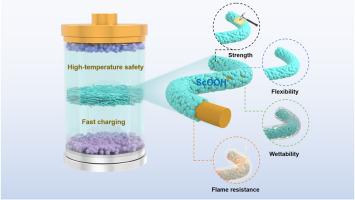原位ScOOH同轴铠装聚酰亚胺纳米纤维分离器,具有高电解质润湿性和热稳定性,适用于高安全性和高倍率容量锂离子电池
IF 9
1区 工程技术
Q1 ENGINEERING, CHEMICAL
引用次数: 0
摘要
随着电动汽车和电网规模储能需求的不断增长,传统的聚烯烃分离器无法满足下一代锂离子电池(LIBs)的热学和电化学要求。本文通过碱蚀刻、吸附络合和水解,开发了一种基于聚酰亚胺的复合分离器(PI@ScOOH),将氧化钪(scoh)原位涂覆在PI纳米纤维基体上。ScOOH涂层引入了纤维之间的物理交联,显著提高了机械完整性。与聚烯烃分离器相比,PI@ScOOH具有优越的电解质润湿性(接触角:9.05°vs 48.53°)和热尺寸稳定性(TMA起始时间:350°C vs 140°C)。阻燃试验证实了其优良的安全特性。使用NCM811/Li充满电池的电化学评价表明,与聚烯烃相比,PI@ScOOH分离器具有更高的容量保持率(在1C下循环300次后为96.7% vs 90.9%)和增强的倍率容量(在10C下为142.8 mAh·g−1 vs 106.9 mAh·g−1)。值得注意的是,该分离器在120°C下保持了90分钟的运行稳定性,远远超过了传统分离器10分钟的极限。这些结果表明PI@ScOOH是一种新型的锂离子电池隔膜,具有增强的安全性和电化学性能。本文章由计算机程序翻译,如有差异,请以英文原文为准。

In-situ ScOOH coaxially armored polyimide nanofibrous separator with high electrolyte wettability and thermostability for high-safety and high-rate capability lithium-ion batteries
With the growing demand for electric vehicles and grid-scale energy storage, conventional polyolefin separators fall short in meeting the thermal and electrochemical requirements of next-generation lithium-ion batteries (LIBs). Herein, a polyimide-based composite separator (PI@ScOOH) was developed via alkali-etching, adsorption–complexation, and hydrolysis to in situ coat scandium oxyhydroxide (ScOOH) onto a PI nanofiber matrix. The ScOOH coating introduced physical crosslinking among fibers, significantly enhancing mechanical integrity. Compared to polyolefin separators, PI@ScOOH exhibited superior electrolyte wettability (contact angle: 9.05° vs 48.53°) and thermal dimensional stability (TMA onset: 350 °C vs 140 °C). Flame retardancy tests confirmed its excellent safety characteristics. Electrochemical evaluation using NCM811/Li full cells showed that the PI@ScOOH separator achieved higher capacity retention (96.7 % vs 90.9 % after 300 cycles at 1C) and enhanced rate capability (142.8 mAh·g−1 vs 106.9 mAh·g−1 at 10C) relative to polyolefin counterparts. Notably, the separator maintained operational stability at 120 °C for 90 min, far exceeding the 10-min limit of conventional separators. These results indicate that PI@ScOOH is a new type of lithium-ion battery separator with enhanced safety and electrochemical properties.
求助全文
通过发布文献求助,成功后即可免费获取论文全文。
去求助
来源期刊

Journal of Membrane Science
工程技术-高分子科学
CiteScore
17.10
自引率
17.90%
发文量
1031
审稿时长
2.5 months
期刊介绍:
The Journal of Membrane Science is a publication that focuses on membrane systems and is aimed at academic and industrial chemists, chemical engineers, materials scientists, and membranologists. It publishes original research and reviews on various aspects of membrane transport, membrane formation/structure, fouling, module/process design, and processes/applications. The journal primarily focuses on the structure, function, and performance of non-biological membranes but also includes papers that relate to biological membranes. The Journal of Membrane Science publishes Full Text Papers, State-of-the-Art Reviews, Letters to the Editor, and Perspectives.
 求助内容:
求助内容: 应助结果提醒方式:
应助结果提醒方式:


